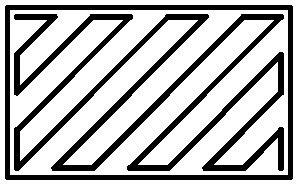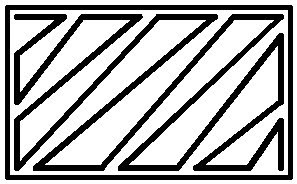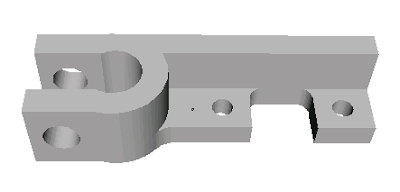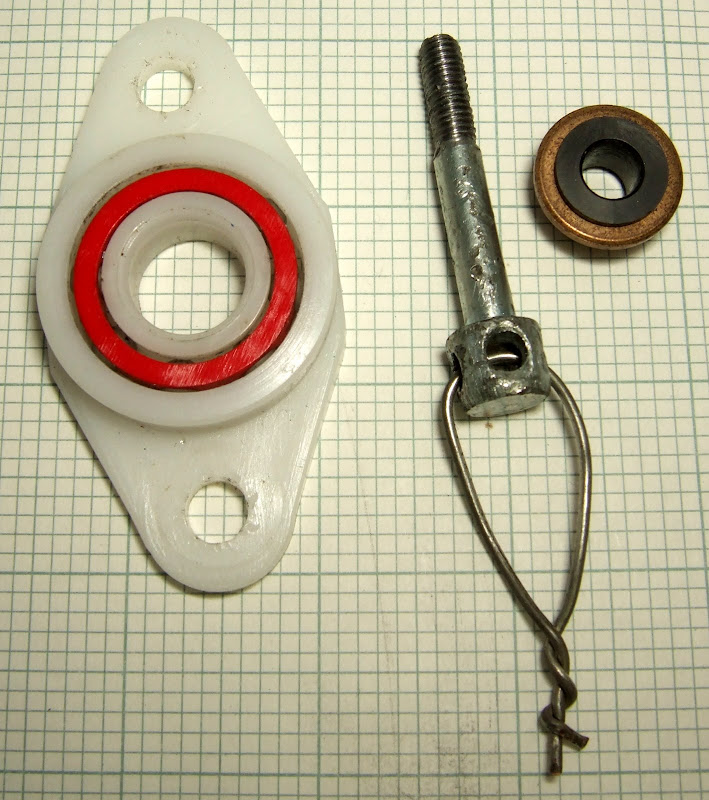I was curious to see how
polycaprolactone (PCL, trade name CAPA) compares to HDPE. I bought some from
BitsFromBytes a while ago but have not had chance to try it yet. It is the plastic RepRap was designed for and there is plenty of
evidence on the web that it does not warp like HDPE does.
The first test I did was to run the extruder at various flow rates and look at the filament diameter and the amount of motor power required. Although I think I only need to extrude at twice the melting point minus ambient (~100°C) to get it to stick to the next layer, the extruder seemed to struggle a bit so I did the tests at 140°C (measured at the nozzle).
This is how the motor duty cycle varied with demanded flow rate: -

The first surprise: although the torque required for PCL through a 0.5mm hole starts off lower than HDPE through 0.5mm, it actually rises faster with flow rate and ends up needing more torque than HDPE through a 0.3mm hole. This became a problem when I started to try to make objects because the clutch in the GM3 gearmotor kept slipping. It never slipped when I was extruding HDPE. I tried loosening the pump springs to the point where the filament started to slip and I tried backing off the flow rate but to no avail. I even replaced the GM3 in case the clutch was worn. I solved it by lubricating the filament with oil, a tip I got from Vik Olliver who found it necessary for
PLA, the other RepRap plastic. I did that by passing it through a felt pad with a hole in the middle, with a few drops of 3 in 1 oil applied.

I found the felt disc in the road, I have no idea what it is, but it I thought it might come in handy someday. If anybody recognises what it is please let me know.
The oil is very effective, a few drops lasts for many hours. Previously I was using PTFE spray to lubricate the pump for HDPE but that required opening the extruder occasionally.
The amount of spring pressure required for PCL is much less that HDPE, presumably because it is much softer so less force is required to make the screw bite.
Next I measured the die swell: -

PCL has far less die swell than HDPE, such that PCL filament from a 0.5mm hole is actually smaller than HDPE from a 0.3mm hole. Reducing the hole size to get smaller filament gives diminishing returns because the die swell as a percentage goes up with a small hole.
I also looked at how motor torque and die swell are affected by temperature. Once I had fixed the clutch slipping problem by lubricating the filament I had no problem extruding at low temperatures.

Quite a big variation in die swell indicating the viscosity changes a lot over this temperature range. This is also obvious looking at the filament. In fact some of the reason why it gets thinner at high temperature is that it is so runny that gravity probably stretches it. That may account for the inflection in the graph, or it may just be measurement error.
The next graph was another surprise: motor duty cycle plotted against temperature: -

This is essentially flat, the slight rise is probably due to the motor windings getting warm, increasing their resistance and thus lowering it's torque. The 160°C reading was taken after the motor had had time to cool down again. This is a good illustration of why a shaft encoder is necessary to control the feed rate.
So if the viscosity is changing, but it has no effect on the motor duty cycle, I have to conclude that most of the torque is required to overcome the friction in the filament guide. That also explains why more torque is required to extrude PCL than is required for HDPE, despite it being less viscous and requiring less spring force. If I rub my fingers over PCL it is obviously a lot less slippery than HDPE.
Having got the filament to extrude properly the next task was to get it to stick to the bed. I found that PCL does not stick to the PP board that I used for HDPE. I expect that is because it is too low a temperature to form a weld with PP.
The RepRap Darwin machine use MDF so I decided to try that.

I assumed that I could dispense with the raft that I lay down for HDPE, but that was not the case. I found that PCL objects still curled away from the base, so I went back to using the raft. That holds the object flat but is a pain to trim off. For some reason it is easier to cut HDPE with scissors even though it is stronger. One downside of using MDF is that some of it comes off with the object so it is not completely reusable and it leaves wood fibers embedded in the base of the the raft. This is nowhere near as good as a polypropylene bed is with HDPE. That peels away undamaged and leaves no trace on the object. I think I need to do some more experiments to find a similar solution for PCL.
The first test shape I made came out very grey. It must have picked up some contamination in the extruder but the only thing that should have been in it was left over HDPE. Perhaps for some reason white HDPE plus white PCL makes a grey plastic.

It was very flat to start with but over a few days it has warped slightly. The corners are lifted about 0.21mm compared to 0.53mm for a 100% filled HDPE block. That is also better than my polyurethane filled 25% HDPE block which had 0.25mm warping.
I think the reason PCL shrinkage is so much less is that although it melts at 60°C, it doesn't harden again until it is around 40°C. That means after setting it only cools a further 20°C back to room temperature. In contrast HDPE probably goes hard around 120°C so it cools a further 100° after that. Even if they had the same thermal expansion coefficient, PCL would shrink five time less.
I did the first test at 8 mm/s because that is as fast as I could go with HDPE with my current nozzle. However, I found that I can go at 16mm/s again with PCL. I have a fan running continuously to cool the object because otherwise PCL takes for ever to set.
I made a second block and that came out white: -

It was extruded at 100°C, 0.5mm filament at 16mm/s, 0.4mm layer height, 0.6mm pitch. The reason for having the height so much less than the pitch with HDPE was that the object shrinks in height while it is being built, otherwise the nozzle ends up extruding into fresh air. Perhaps with PCL I can get away with a smaller filament aspect ratio.
Here is a longer test piece with a 25% fill HDPE equivalent underneath for comparison: -

The PCL shrinks far less but at 100% fill is not as strong as the HDPE at 25% fill. I can also make 25% filled PCL objects but they are very flexible. Presumably PU injection would work with PCL as well and get the strength back.
The brush that I use to wipe the nozzle does not work as well with PCL. With HDPE any bits left stuck to the brush get knocked off on the next wipe cycle. With PCL they get picked up again by the nozzle on the next pass. I need to go back to using a knife I think, as shown
here.
My acorn nut nozzle didn't work very well with HDPE compared to the one piece nozzle I used before, but it works much better with PCL. I get less extruder overrun and I can extrude quickly without the filament snapping.
PCL filament is much more compliant so the minimum corner radius is less and definition is generally much better. Some of this may be due to being able to run my fan again. I found that it improved HDPE definition but it pushes the heater temperature up above the point where the PTFE insulator goes soft.
So to summarise:
HDPE:
- Rigid.
- Cheap.
- Readily available.
- Handles high temperatures.
- Shrinks a lot leading to warping.
- High die swell.
- Doesn't stick to anything.
PCL:
- Springy.
- Expensive.
- Hard to get hold of in filament form.
- Doesn't handle high temperatures.
- Shrinks less leading to less warping.
- More compliant leading to better corner definition.
- Low die swell.
- Sticks to far more things.
- Has green credentials.
PCL seems better in all aspects that affect making accurate objects. HDPE is better in all other respects.
HDPE seems to push the extruder temperature wise and PCL seems to push it torque wise. I think a stainless steel barreled extruder with a PTFE lined filament guide will solve these problems.
The PCL results look easily accurate enough to make the Darwin parts so I need to hook up my machine with the host software and start churning them out. The HDPE results are probably good enough for some parts and probably beneficial for motor couplings and mountings which get hotter than 60°C.
Before that I will have a go with ABS and then do some more work on my high temperature extruder design.




















































